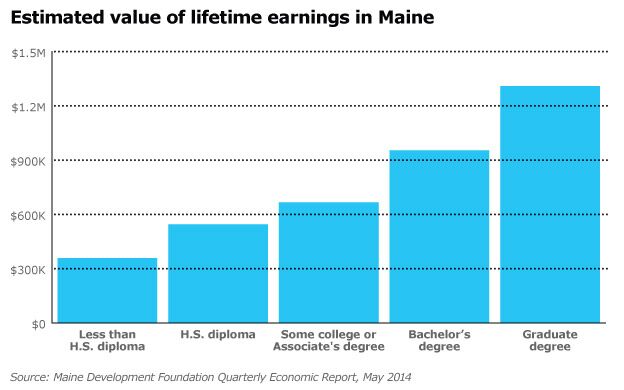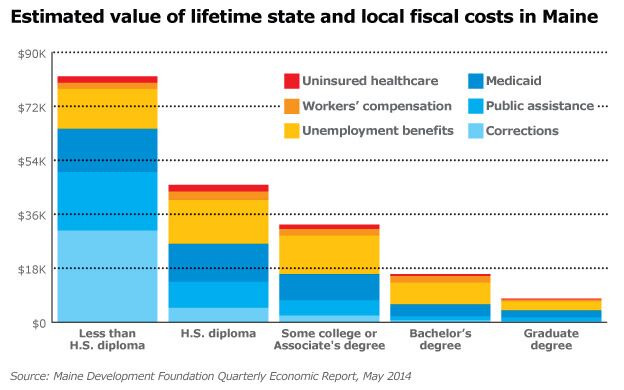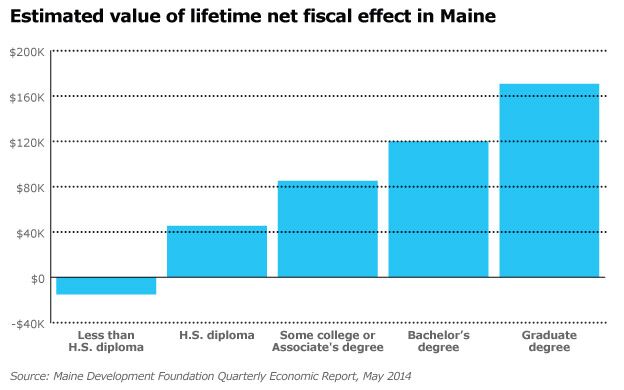Maine’s colleges and universities struggle with shrinking budgets
To many, it's not news that higher education can dramatically increase the lifetime earnings prospects for graduates, no matter where they elect to study.
For years, national and regional studies have shown that those earning bachelor's degrees are projected to earn almost twice as much over their careers as those who have only a high school diploma, and the gap is nearly three times for those who don't finish high school.
Yet stories about recent graduates working at menial jobs — or none at all — and defaulting on students loans have apparently had a significant, or at least anecdotal, effect. Openly questioning the value of a college education has become common.
“That's one of the reasons I decided to undertake this work,” says Phil Trostel, professor of economics at the University of Maine, and the author of a new Maine Development Foundation report, “The Fiscal Return on Higher Education in Maine.”
Its conclusion is clear and unambiguous: “There is a common belief that young adults cannot remain in Maine because there are no good jobs for college graduates here. This unfortunate notion is, however, clearly refuted by data on earnings.”
Trostel's findings, which focus directly on Maine graduates, reinforce what several national studies have found: Not only is there still a substantial premium for higher education, it has grown since the onset of the financial crisis in 2008.
“There are always going to be some graduates who start out waitressing, or have a hard time paying their loans,” Trostel says in an interview. “But over time, the differences in earnings are quite dramatic.”
The study shows that a bachelor's degree creates a 75% earnings increase over a lifetime, and more education translates into higher pay at every level. Where a high school graduate can expect to earn $545,360 over a lifetime and a college graduate $953,937, those with graduate degrees can expect to earn $1.3 million.
Trostel also focuses on other variables besides earnings. Education also has a powerful effect on the public sector, both in taxes paid and in the amount of services required. Those with less than a high school education will contribute $67,081 in state income and sales taxes, and local property taxes, while those with graduate degrees will pay almost three times as much — $178,687.
Examining anticipated costs for six major state public services — corrections, unemployment, public assistance, worker's compensation, Medicaid and uncompensated care — another chart shows the opposite pattern. Those without a high school degree will require $82,021 in public spending, while those with graduate degrees, only $7,862.
Antidote for the ‘malaise’
Considering the overwhelming nature of these numbers, why is there so much concern about whether enrolling in college is really a good move?
Laurie Lachance, a former MDF president and now president of Thomas College in Waterville, says she senses “a mood of disillusionment with higher education.”
“There are concerns that the delivery of services is not as efficient, or even as effective, as it should be,” she says. The prolonged economic slump, she adds, “has led to questioning of just about every kind of investment.”
As a higher education leader herself, she recognizes the effects of this “malaise.” She says, “What we're seeing is that the public is not happy with us, and that we need to win back the public trust.”
Charles Colgan, professor at the Muskie School of Public Service at the University of Southern Maine, says that there is indeed a crisis in public higher education funding, but says it's been going on a lot longer than just the recent economic downturn.
“In the entire 45-year history of the University of Maine System, there had been only two times when the state put a significant amount of new money into programs,” Colgan says.
The first was when a visiting committee advocated a “down payment” of $20 million in the 1980s during the tenure of Gov. Joseph E. Brennan. At the time, the state Legislature approved the spending, but funding was later curtailed during the recession of the early 1990s.
The second funding bump was in the late 1990s, during then-Gov. Angus King's administration. That funding was “significant,” in Colgan's view, but targeted specifically to research and development rather than university programs as a whole.
Since 2008, the state appropriation for the university system has stayed at around $178 million, even as costs have gone up, he says. “And if you look at the chancellor's new five-year plan, they're not anticipating any increases over that period, either.”
If that forecast holds true, the state appropriation for higher education will have declined, in real dollars, every year for more than a decade.
Link between education and health
If the future looks bleak, that only means that those concerned with higher education and the future of Maine's workforce need to redouble their efforts, in Lachance's view.
“I've been studying economic development from every angle for the last 30 years, and the one factor that always rises to the top, in almost every survey, is how valuable education really is,” she says. “It's the one thing we can control that pays off in every way we can measure.”
The effects of education go beyond the value of earnings or even the resulting positive effect on government revenues, she says: “Health is much more closely related to education that we realized.” Chronic disease and the frequency of smoking both decline as people become more educated, she says. “It's not just about earnings, but about how much people can enjoy their lives and contribute to their community.”
Role of business
The business community has a role to play here, too, says Ryan Neale, a program director at MDF who commissioned the report. Neale points out that MDF programs such as the Economic Growth Council bring together business leaders with elected officials in an attempt to reinforce pro-growth policies in both the public and private sectors.
Traditionally, business leaders have made up a large proportion of the MDF board; Aldo Servello, Cianbro CFO and treasurer, is the current chair, while Jonathan Edgerton, senior vice president at Wright-Pierce, is vice chair.
The higher education report is an attempt to expand on the findings of “Measures of Growth,” the council's annual scorecard on Maine's economic and educational climate, Neale says. “There's only so much we can do in a single page. These quarterly reports flesh out what's behind the numbers that are published year after year.”
The higher education report, published in May, is the third in a series. The other reports, which appeared last year, focused on productivity and per capita income.
“When times are hard, cutting the university budget is the politically expedient thing to do. Understandably, legislators are protective of K-12 funding, which directly affects their own districts,” says Trostel, who has done studies of public education over the past two decades and has a joint appointment with the Margaret Chase Smith Policy Center at UMaine.
Studies of higher education around the country show that “there are disproportionate fluctuations” in state support for public colleges and universities compared with other programs, he says. In Maine, he adds, what goes down rarely seems to come back up.
At USM, Colgan admits to a certain amount of frustration with this process. “We find the one thing about state spending that's entirely under our control and really makes a difference in improving the fortunes of our state, and we don't fund it,” he says. “Politicians are often looking at the next election cycle to make a difference. This is an investment that has to be sustained over time.”
Lachance thinks, however, that higher education may be at the low ebb of a cycle that's characterized by larger forces than just budget decisions. “We need to win back the public trust,” she says, “and I think we will win it back.”
Efforts to revamp programs to meet contemporary needs and to demonstrate results in the workplace will eventually pay off, she believes.
In the meantime, getting the word out, even if it sounds familiar in some respects, is well worth doing.
Trostel, having crunched the numbers on a Maine-specific basis, is continuing his work on a broader scale. In an upcoming report, he examines the “lesser known effects” of access to education — not only how it's correlated with improved health, but more lasting marriages and other aspects of personal happiness.
These qualities in turn have desirable public outcomes, such as reduction in crime, increased philanthropy and greater civic engagement.
One of the reasons those studying the effects of higher education say it doesn't necessarily register with the public is that it takes a long time to play out.
Trostel counsels patience in assessing whether even an individual's experience confirms these findings. “It may not look like that big a difference a few years following graduation,” he says. “But if you come back after a decade or more, the payoff is there.”
Read more
Eastern Maine seventh fastest-growing community college in U.S.














Comments